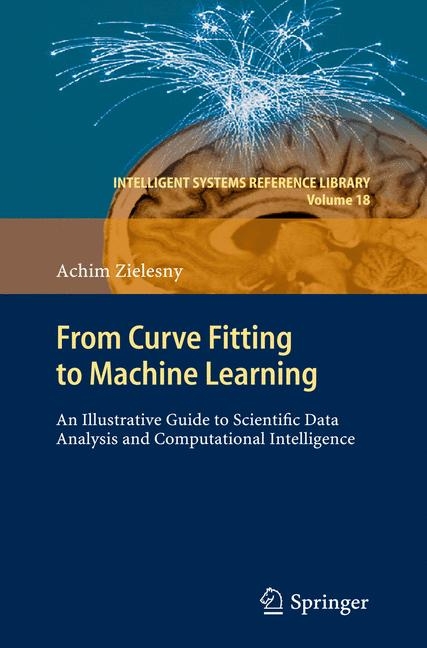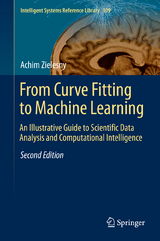
From Curve Fitting to Machine Learning
An Illustrative Guide to Scientific Data Analysis and Computational Intelligence
Seiten
2013
|
2011
Springer Berlin (Verlag)
978-3-642-27112-0 (ISBN)
Springer Berlin (Verlag)
978-3-642-27112-0 (ISBN)
- Titel erscheint in neuer Auflage
- Artikel merken
Zu diesem Artikel existiert eine Nachauflage
Experimental data analysis is at the core of scientific inquiry, and computers have taken this function to a new level. This volume is an interactive guide to complex modern analytical processes from non-linear curve fitting to clustering and machine learning.
The analysis of experimental data is at heart of science from its beginnings.
But it was the advent of digital computers that allowed the execution of highly non-linear and increasingly complex data analysis procedures - methods that were completely unfeasible before. Non-linear curve fitting, clustering and machine learning belong to these modern techniques which are a further step towards computational intelligence.
The goal of this book is to provide an interactive and illustrative guide to these topics. It concentrates on the road from two dimensional curve fitting to multidimensional clustering and machine learning with neural networks or support vector machines. Along the way topics like mathematical optimization or evolutionary algorithms are touched. All concepts and ideas are outlined in a clear cut manner with graphically depicted plausibility arguments and a little elementary mathematics. The major topics are extensively outlined with
exploratory examples and applications. The primary goal is to be as illustrative as possible without hiding problems and pitfalls but to address them. The character of an illustrative cookbook is complemented with specific sections that address more fundamental questions like the relation between machine learning and human intelligence. These sections may be skipped without affecting
the main road but they will open up possibly interesting insights beyond the mere data massage.
All topics are completely demonstrated with the aid of the commercial computing platform Mathematica and the Computational Intelligence Packages (CIP), a high-level function library developed with Mathematica's programming language on top of Mathematica's algorithms. CIP is open-source so the detailed code of every method is freely accessible. All examples and applications shown throughout the book may be used and customized by the reader without any
restrictions.
The target readerships are students of (computer) science and engineering as well as scientific practitioners in industry and academia who deserve an illustrative introduction to these topics. Readers with programming skills may easily port and customize the provided code.
The analysis of experimental data is at heart of science from its beginnings.
But it was the advent of digital computers that allowed the execution of highly non-linear and increasingly complex data analysis procedures - methods that were completely unfeasible before. Non-linear curve fitting, clustering and machine learning belong to these modern techniques which are a further step towards computational intelligence.
The goal of this book is to provide an interactive and illustrative guide to these topics. It concentrates on the road from two dimensional curve fitting to multidimensional clustering and machine learning with neural networks or support vector machines. Along the way topics like mathematical optimization or evolutionary algorithms are touched. All concepts and ideas are outlined in a clear cut manner with graphically depicted plausibility arguments and a little elementary mathematics. The major topics are extensively outlined with
exploratory examples and applications. The primary goal is to be as illustrative as possible without hiding problems and pitfalls but to address them. The character of an illustrative cookbook is complemented with specific sections that address more fundamental questions like the relation between machine learning and human intelligence. These sections may be skipped without affecting
the main road but they will open up possibly interesting insights beyond the mere data massage.
All topics are completely demonstrated with the aid of the commercial computing platform Mathematica and the Computational Intelligence Packages (CIP), a high-level function library developed with Mathematica's programming language on top of Mathematica's algorithms. CIP is open-source so the detailed code of every method is freely accessible. All examples and applications shown throughout the book may be used and customized by the reader without any
restrictions.
The target readerships are students of (computer) science and engineering as well as scientific practitioners in industry and academia who deserve an illustrative introduction to these topics. Readers with programming skills may easily port and customize the provided code.
Introduction.- Curve Fitting.- Clustering.- Machine Learning.- Discussion.- CIP - Computational Intelligence Packages.
From the reviews:
"'From curve fitting to machine learning' is ... a useful book. ... It contains the basic formulas of curve fitting and related subjects and throws in, what is missing in so many books, the code to reproduce the results. ... All in all this is an interesting and useful book both for novice as well as expert readers. For the novice it is a good introductory book and the expert will appreciate the many examples and working code." (Leslie P. Piegl, Zentralblatt MATH, Vol. 1236, 2012)
| Reihe/Serie | Intelligent Systems Reference Library |
|---|---|
| Zusatzinfo | XV, 465 p. |
| Verlagsort | Berlin |
| Sprache | englisch |
| Maße | 155 x 235 mm |
| Gewicht | 735 g |
| Themenwelt | Technik |
| Schlagworte | Dissipation • Energy • Hamilton’s Variational Principle and its Generalization • Variational-Asymptotic Method |
| ISBN-10 | 3-642-27112-X / 364227112X |
| ISBN-13 | 978-3-642-27112-0 / 9783642271120 |
| Zustand | Neuware |
| Haben Sie eine Frage zum Produkt? |
Mehr entdecken
aus dem Bereich
aus dem Bereich
Lern- und Arbeitsbuch (mit digitalem Training zum Downloaden)
Buch (2024)
SecuMedia (Verlag)
CHF 43,95
Praxiswissen zu Schimmelpilzschäden in Gebäuden: Mikrobiologie, …
Buch | Hardcover (2024)
Reguvis Fachmedien (Verlag)
CHF 138,60



